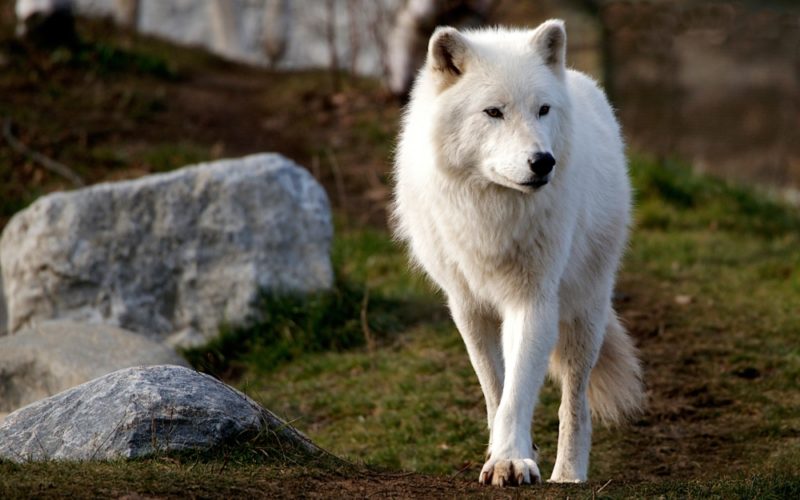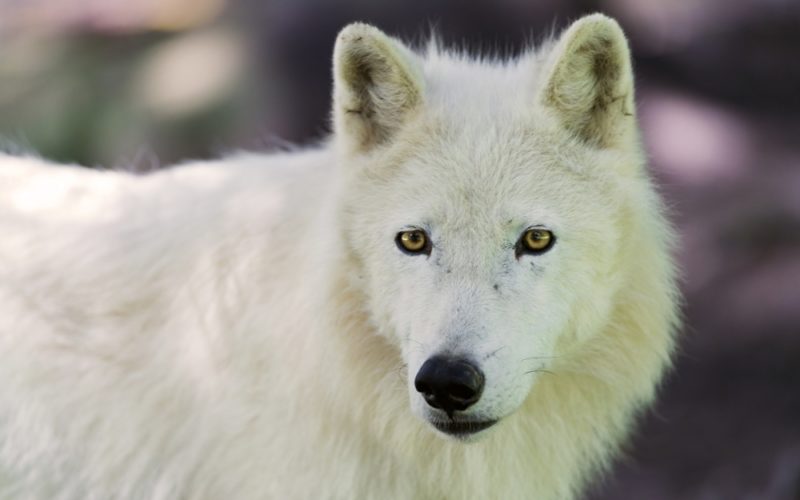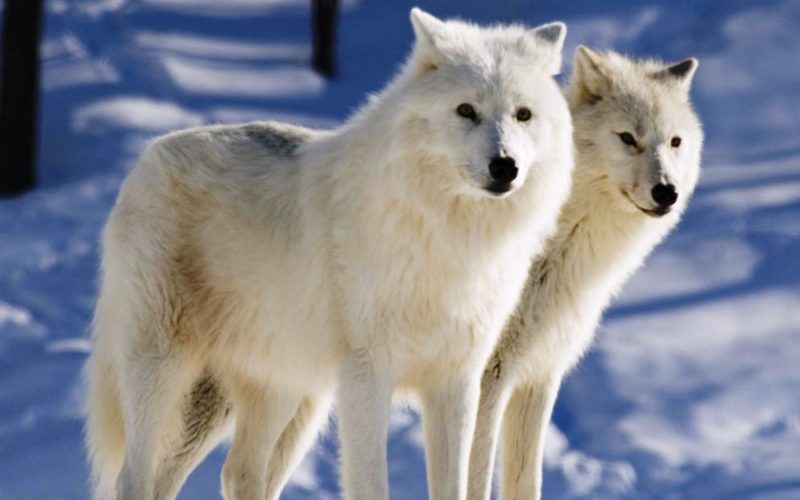An ominous howl, from which the blood freezes, an intelligent piercing gaze, graceful posture - before us is a white wolf. He came out of the snow to declare, "I am the master of the harsh Arctic!"
Material Content:
White Wolf Description
The polar wolf is a subspecies of the common breed.
From the gray and tundra counterpart it is distinguished:
- larger size;
- pure white or reddish color;
- fluffy low tail, like a fox.
Thanks to the color of the fur, it imperceptibly approaches the prey, merging with snow-white snowdrifts.
The combination of stiff outer hair and thick soft undercoat protects the predator from the cold at -50 ° C and below, strong ice winds and injuries in fierce battles.
Parameters of an adult animal:
- height at the withers - 70 - 90 cm;
- body length, including tail - 140 - 180 cm;
- weight –70 - 90 kg.
Males are 15% larger than females.
Whiskers frame the elongated and wide face of the animal. In appearance, the wolf resembles a large dog.
The build of the beast was created for hunting in the Arctic. Long strong limbs allow you to pursue prey at distances of up to 100 km per day.
The speed of movement of the predator is 10 - 15 km / h, at the time of the attack on the prey it reaches up to 60 km / h.
Polar Predator Habitat
The polar wolf inhabits the Arctic, with the exception of icy areas and floating fragments. It is difficult to get food and prepare a lair.
The predator is found in the north of Canada and Russia, in Alaska, in Greenland. He adapted well to the conditions of the tundra. Temperature from - 30 ° С, permafrost, icy winds, lack of sunlight for 5 months - his habitual habitat.Night is the main time of his activity.
Character, socialization and nutrition
The composition of the flock - 5 - 10 individuals from among direct relatives. This is the best amount for a wolf family to hunt and feed efficiently. The main pair is a male leader and his female. The remaining members of the pack are cubs, several young wolves from previous litters, and old men.
The leader is an alpha male, then his female follows the hierarchy. The remaining family members obey them.
The tail raised up is the difference between a leader and his brothers. The main she-wolf closely monitors other females, while keeping her distance.
The hierarchy in the pack is tough. A pair of leaders produces offspring, makes decisions, directs the hunting process. The rest only follow the instructions.
Individuals of a lower rank express submission in the following ways:
- pressed to the ground;
- lie on your back;
- eating prey last.
In the event of the death of the leader, his place is taken by the most powerful male. Sometimes young wolves leave the pack to create their own, to become the main ones. They find a new territory, a companion of life, mark the boundaries of their possessions. If they are unable to start a family, then they remain in the pack on secondary roles.
Bloody conflicts within the family are a rarity. Wolves are at enmity with other packs when it comes to an attempt on their territory.
Individuals communicate among themselves growling, barking, screeching. Wolves hail howl other flocks. They declare their presence in order to avoid bloody fights for the territory. Sometimes predators resort to polyphony. This discourages potential rivals from mining.
Polar wolves are not picky about food. They eat everything that they catch on the hunt. The feeding of the polar wolf is reindeer, musk ox. Predators migrate after the herds, tracking down prey, setting up ambushes. A flock calculates and kills weak driven animals. Sometimes wolves get tired faster than potential prey and are left with nothing.
In case of unsuccessful hunting for large artiodactyls, the owners of the Arctic eat rodents, polar hares, waterfowl, and small predators. Frogs, beetles, forest fruits, lichens diversify the diet in the summer months.
In one meal, wolves can eat up to 10 kg of meat, including bones, the skin of the victim. 42 sharp teeth can grind hard fragments. Predators can go without food for up to 2 weeks.
Life expectancy and reproduction
In natural conditions, wolves live 7, in captivity - up to 20 years. The mating season is from January to March. Outside the pack, the males fight for the chosen one, proving their superiority. New couples make a den in a cave, a crevice of a rock, a depression in the ground, give birth to offspring.
The gestation period of the female is 62 to 75 days. In May - June, 2 to 3 babies are born, less often - more than 5 individuals. The weight of newborn babies is about 400 grams. Wolfs are born blind. They open their eyes on days 9-12, get on their feet, try to walk, show interest in what is happening around.
The first 6 weeks, puppies feed on mother's milk. Then the father is connected to the feeding process. He brings chopped meat in the stomach, shares it with a she-wolf, offspring. Soon, the kids begin to learn the art of hunting under the strict guidance of their parents. Male and female acquaint them with the methods of tracking the victim, preventing danger. The young live with their mother up to 2 years.
Interesting facts about a beautiful animal
Learn interesting lifestyle facts that are unique to these predators:
- Animal white wolf - one of the best parents in the wild. All family members take care of the puppies. If the mother goes hunting, young wolves remain with the cubs. They feed them, if there is not enough food, accompany them in sorties from the den, play.
- Legends circulate about the mind and organization of predators. According to deer breeders, the she-wolf mother can distract the shepherd so that the flock can attack the herd.
- The beast eats prey as a whole, including the skin, the bones of the victim.The reason for this eating behavior is hungry weeks due to difficulties finding food. Luck on a hunt smiles at wolves only 1 out of 10 times.
- White predators are monogamous. They create couples for life. Family replenished by their children.
Hunting a white wolf is prohibited by law. The breed is listed in the Red Book.
This beautiful and proud animal made the ancestors desire to tame it. Partially it turned out. According to one version, the polar wolf is a prototype of a Samoyed dog. However, the beast did not completely submit to man.















